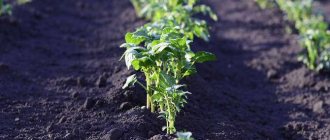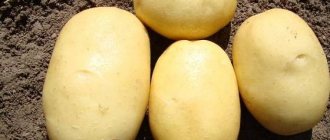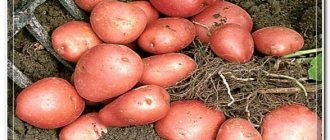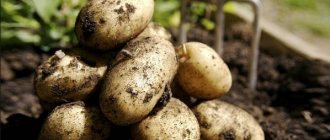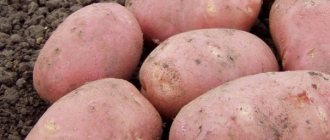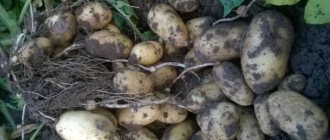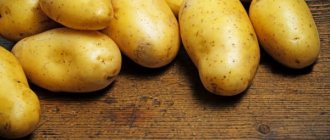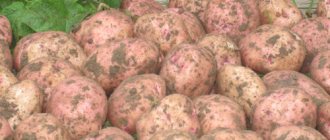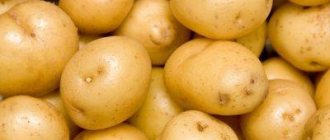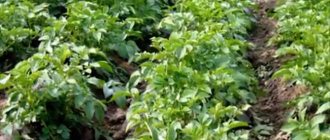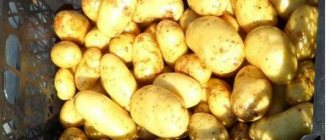Labella is a table potato variety bred by specialists from Solana (Germany). Included in the State Register of the Russian Federation in 2011 for the North Caucasus region. If agricultural practices are followed, the bushes are practically not affected by diseases and pests. Due to their unpretentiousness, productivity and high quality of tubers, Labella potatoes are cultivated on an industrial scale for processing and sale, as well as in large and small subsidiary farms.
The history of the origin of the Labella potato variety
The “Labella” variety is the result of the work of German breeders of the large company Solana, whose specialization is high-yielding hybrids of various crops.
Year of entry into the State Register: 2011.
The table presents data on the mass of marketable tubers (grams) of different varieties:
| Name | Variety | Weight |
| Nikulinsky | Late ripening | From 70 to 120 |
| Cardinal | Late ripening | 65-110 |
| Rocco | Late ripening | 100-120 |
| Picasso | Late ripening | 80-140 |
| Borovichok | Early ripening | 120-200 |
| Elmundo | Early ripening | 120 |
| Felox | Early ripening | From 100 to 120 |
| Bellarosa | Early ripening | From 120 to 210 |
| Karatop | Extra early | From 58 to 100 |
| Zhukovsky early | Extra early | 100 to 120 |
| Farmer | Extra early | From 90 to 110 |
| Minerva | Extra early | From 120 to 245 |
| Sorcerer | Mid-late | From 75 to 120 |
| Mozart | Mid-late | From 100 to 150 |
| Grenada | Mid-late | From 800 to 100 |
| Melody | Mid-late | From 95 to 180 |
| Giant | Mid-early | 100-140 |
| Tuscany | Mid-early | From 90 to 125 |
| Purple Haze | Mid-early | From 90 to 160 |
| Openwork | Mid-early | 90-120 |
Recommended regions for cultivation:
- Central;
- Central Black Earth;
- Volgo-Vyatsky;
- North Caucasian;
- Far Eastern.
Description of the variety
Roots:
- Elongated oval tubers;
- Quite small eyes, medium deep;
- Red peel;
- The pulp is yellow;
- Average weight varies from 78 to 102 grams;
- Starch content no more than 15.8%;
- The harvest from one bush is up to 14 tubers.
Escapes:
- The plant is low, compact, erect, not spreading;
- Small leaves, dark green, slightly wavy edges;
- Small pink-violet flowers are collected in neat corollas;
- Well developed root system.
Frying and frying varieties
For frying and making fries, varieties with a low starch content of less than 15% are suitable; they retain their shape well and do not crumble.
Watch the video! Which potato is best for French fries?
Rocco (Rocco)
Mid-season variety with good taste when cooked. The tubers will ripen in 90-110 days.
Doesn't get soggy when cooked. Roko can be used to make salads, chips and fries, and these potatoes can also be added to soups and fried.
Characteristic:
- Average ripening period (90-110 days).
- The skin is red, the flesh is white.
- Starch concentration – 12-14%.
- On average, it weighs about 75-120 g; under a bush there can be about 8-12 pieces.
- Resistant to cancer, golden nematode, mosaic.
- Has average immunity to late blight.
Naiad
Mid-early, high-yielding, with excellent taste when cooked. The tubers will ripen in 80-85 days.
Suitable for cultivation in Russia, Belarus, Ukraine and Moldova. Potatoes are used to make chips, fries, etc.
Characteristic:
- Mid-early ripening (80-85 days).
- High yield - 200-350 c/ha
- The peel is yellow, the flesh is white.
- On average, the weight of a tuber is 70-120 g.
- It has high immunity to nematodes and late blight.
Advantages, disadvantages and taste qualities
The Labella variety has the following advantages:
- Evenness of tubers, absence of both too large and too small root crops;
- Low maintenance requirements;
- Excellent productivity;
- Resistant to high temperatures;
- Drought resistant;
- Excellent commercial qualities of tubers;
- High taste qualities;
- Excellent storage of the harvested crop;
- Transportability;
- Resistant to most diseases.
Labella has no disadvantages. The only difficulty is instability to frost.
Positive and negative sides
The Labella variety has many advantages. Experienced gardeners note the following advantages of Labella:
- Exceptional appearance of the fruit. All tubers are smooth and beautiful.
- High yield variety. From 1 hectare of planting you can safely cultivate up to 300 centners.
- Labella is easy to care for.
- Potatoes tolerate short-term drought well.
- The tubers are sweetish, not watery.
- High shelf life – up to 98%.
- Immunity to mechanical influences. Thanks to this, Labella can be easily transported and removed mechanically.
- Good immune system.
- Potatoes are rich in starch, minerals and carotene.
Of the shortcomings, only one is worth highlighting - instability to low temperatures.
Correct fit
Planting dates are determined by weather conditions in the growing area. The Labella variety is planted in compliance with agrotechnical requirements:
- The main tasks of pre-sowing tillage include creating the most loose and fertile soil, which is suitable for the development of potato tubers and has good permeability to moisture, air and heat;
- In the spring, sorting, collecting and germinating seed material begins three weeks before planting;
- Tubers are buried 6-8 cm.
REFERENCE: For planting, it is recommended to use only pure varietal material, tubers of a standard size. If there is a shortage of seed material, cutting large tubers (more than 90 grams) is permissible. The tubers are cut directly on the day of planting.
Pros and cons of selection
- Labella has many advantages, given its versatility and ease of care:
- uniform size of tubers, no oversized giants and small peas;
- high yield;
- undemanding to the frequency of watering;
- resistance to fog, heat, drought, high humidity and other natural phenomena;
- excellent presentation;
- acceptable indicators of transportability and safety;
- protection against diseases to which potatoes may be exposed has been developed;
- excellent taste;
- versatility in cooking (frying, boiling, baking).
- The disadvantages of selection are:
- poor resistance to frost;
- inability to repel insects and pests.
Crochet blouses for women. Schemes and descriptions for beginners: summer, large sizes, with a round yoke
We still have to fight these phenomena on our own.
Care
Care measures for the Labella variety are standard. Potatoes needed:
- Spud. Hilling promotes the formation of additional stolons, increasing the quality and quantity of root crops by almost a third, in addition, it effectively protects plants from possible spring frosts;
- Loosen. Loosening provides air access to the tubers and removes small weeds from the soil (loose the soil shallowly with a rake);
- Fertilize. The first time is fed directly at the time of planting the seed (1 tablespoon of urea or a special solution “Solution”, diluted in 10 liters of water). The second time during the period of bud formation (1 tablespoon of potassium sulfate and 3 tablespoons of ash, diluted in 10 liters of water). The third time during the flowering period, fertilizing allows you to accelerate the formation of root crops (mullein or bird droppings);
ATTENTION: Fertilizers must be applied to well-moistened soil (after rain or watering).
- Water. Watering is recommended only during dry periods, at a rate of at least 12-15 liters per bush;
- Protect from possible diseases. As soon as the first signs of diseases or the threat of their spread appear, spray the potato tops with a solution of Bordeaux mixture or copper oxychloride with the addition of superphosphate.
Features of cultivation
Labella potatoes are undemanding and unpretentious, suitable for beginners in gardening. In order for the harvest to be plentiful and the tubers to be shelf-stable and tasty, you need to perform a few simple manipulations throughout the growing season. Despite its plasticity to the soil, the variety shows the best results in light, fertile sandy loam or sandy soil in open, sunny areas.
Preparatory work
Labella is very sensitive to crop rotation; the variety is not planted in the same place where any nightshade crops, sunflowers, sorghum and carrots grew; these plants have the same diseases and pests. To clear the soil of insects, fungi, bacteria, as well as to enrich and normalize the structure of heavy soil, green manure is sown in late autumn and immediately after the snow melts.
Attention! In the fall, green manure is mowed and left in the beds. In the spring, the herbs are allowed to gain a powerful green mass, cut before flowering and embedded in the soil. The variety does not need mulching.
During pre-winter preparation, the site is dug up and 5 kg of rotted manure, compost or humus is added to each m². In the case where there are few organics, add 10 g of potassium salt and 30 g of superphosphate. It is important not to oversaturate the soil, otherwise Labella will produce powerful greens to the detriment of the tubers. In the spring, the soil is loosened, lumps are broken, a glass of wood ash is added per 1 m² and no more than 1.5 tbsp. l. nitrophoska. A month before planting, the tubers begin to germinate and must be treated.
Diseases and pests
The Labella variety has excellent immunity to a large number of diseases typical of nightshades. Recommended preventive measures:
- Carrying out a one-time treatment of plantings with herbicides;
- When infected, damaged bushes are marked because they are unsuitable for seed. These root crops are the first to be dug up. Cut tops must be burned;
- Wireworms and Colorado potato beetles pose a particular danger to Labella. As a preventive measure, it is necessary to remove all small tubers from the soil during harvesting, since when they decompose they will turn into a breeding ground for pests;
- Change the growing area every three to five years.
Watering and hilling mode
Features of care include the correct irrigation regime and watering of the plant. Watering is the basis for the formation of a good potato harvest. It is important not to overdo it with water, as its excess can lead to late blight.
It is recommended to carry out the first watering at the moment when the bush has risen to a height of 10 centimeters above the ground. During the appearance of inflorescences, the plant needs copious amounts of water. The third time should occur after the disappearance of the inflorescences. After this point, it is not recommended to water the potatoes due to the high activity of late blight.
Weeding is a necessary part of properly growing crops. The hilling process will saturate the soil with oxygen and activate the growth of tubers.
Harvesting
It is imperative to correctly determine the timing of harvesting the potato harvest. Untimely harvesting leads not only to a significant decrease in the quality of root crops, but also to significant yield losses.
We invite you to familiarize yourself with potato varieties that have different ripening periods:
| Late ripening | Early ripening | Very early | Mid-late | Mid-early |
| Nikulinsky | Borovichok | Forty days | Crane | Yanka |
| Cardinal | Elmundo | Karatop | Sorcerer | Giant |
| Rocco | Felox | Riviera | Mozart | Tuscany |
| Kiwi | Bellarosa | Zhukovsky early | Grenada | Purple Haze |
| Ivan da Marya | Natasha | Farmer | Melody | Openwork |
| Picasso | Ariel | Minerva | Margarita | Santana |
| Asterix | Queen Anne | Veneta | Ramona | Desiree |
| Slav | Arosa | Kiranda | Dolphin | Lady Claire |
Reviews about the variety
The Labella variety is recognized by potato growers for its rapid development at the very beginning of growth and for obtaining a high-quality harvest. During harvest, there are almost no both small and overly large tubers. Potatoes have a wonderful rich taste, not watery, slightly sweet. When cut and during cooking, the pulp does not darken and has an average boilability. The variety is suitable for both cooking and frying; it does not lose its shape during heat treatment. Labella tubers are used to produce chips, freeze-dried puree and other finished products.
Potatoes under hay, comparison of yields of 5 varieties:
The Labella potato harvest can be used both for selling early products and stored for a long period. Potatoes are resistant to high temperatures and easy to care for, which is why “Labella” is in demand among beginning gardeners.
Characteristic
The Labella variety is zoned for different regions of Russia and is suitable for industrial cultivation. Potatoes tolerate unfavorable weather conditions, tolerate heat and short-term drought.
The yield is good, up to 300 kg are harvested from 1 hundred square meters. The first tubers can be dug up in early summer. Potatoes reach their maximum yield towards the end of the growing season.
And in the table below you can see what the yield and percentage of tuber marketability are for other potato varieties:
| Variety name | Productivity (c/ha) | Marketability of tubers (%) |
| Labella | 176-342 | 98 |
| Limonka | 195-320 | 96 |
| Melody | 180-640 | 95 |
| Margarita | 300-400 | 96 |
| Aladdin | 450-500 | 94 |
| Courage | 160-430 | 91 |
| Beauty | 400-450 | 94 |
| Grenada | 600 | 97 |
| Mistress | 180-380 | 95 |
The Labella potato bush is low, compact, erect, without spreading branches. The leaves are medium-sized, dark green, with slightly wavy edges. Small pink-violet flowers are collected in compact corollas. The root system is well developed. The bush produces up to 14 large potatoes, the amount of non-marketable small potatoes is minimal.
"Labella" is distinguished by its tolerance to the vagaries of the weather and does not require frequent watering. Potatoes prefer light sandy soil. To increase productivity, balanced mineral fertilizers are recommended, which are applied to the soil at the beginning of the season.
The variety is not too demanding to care for, its agricultural technology is simple, this potato is suitable for beginner gardeners.
Potatoes are resistant to many diseases typical of nightshades. It is rarely affected by potato canker, tuber rot and viruses. Not susceptible to late blight epidemics. The variety is young enough, so the tubers do not degenerate. For sowing, you can use the harvest you collected yourself.
Potatoes of the Labella variety have a wonderful taste: quite rich, not watery, slightly sweet. When cutting and cooking, the tubers do not darken. Cookability is average. Potatoes can be fried or boiled and retain their shape well. The tubers can be used to make chips, freeze-dried purees and other ready-made products.
